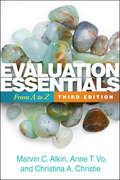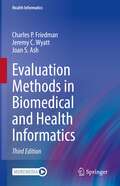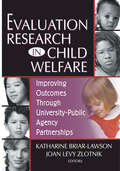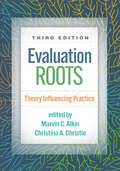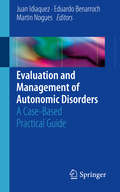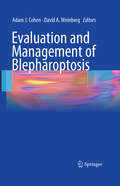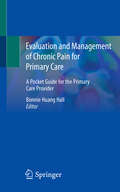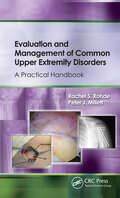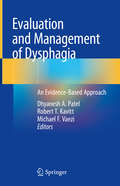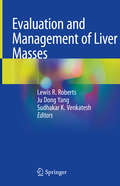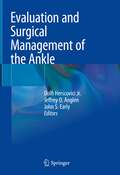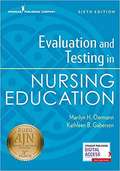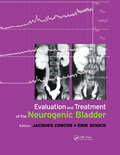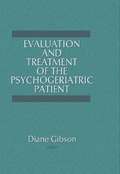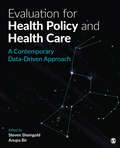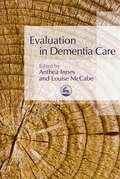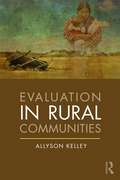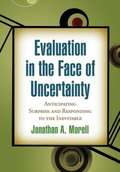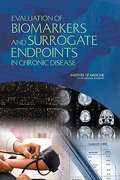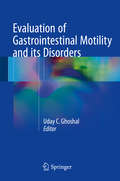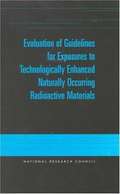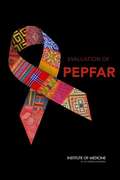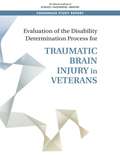- Table View
- List View
Evaluation Essentials: From A to Z
by Christina A. Christie Marvin C. Alkin Anne T. VoBeloved for its conversational style and reliable advice, this text is now in a revised and updated third edition, reflecting key developments in evaluation. It includes expanded coverage of equity and social justice issues, values and cost analysis, visualizing qualitative data with software, and more. Twenty-six concise chapters, or "sessions," give students, applied researchers, and program administrators a solid foundation for conducting or using evaluations. Covering both quantitative and qualitative methods, the book emphasizes fostering evaluation use. It shows how to build collaborative relationships with users; formulate answerable evaluation questions; deal with contingencies that might alter the traditional sequence of an evaluation; and collect, analyze, and report data. Student-friendly features throughout the sessions include titles written as questions, bulleted recaps, "Thinking Ahead" and "Next Steps" pointers, cautionary notes, and annotated suggestions for further reading. An in-depth case study provides the basis for end-of-session practice exercises. New to This Edition *New sessions on context-sensitive evaluation, including the organizational, sociopolitical, and community contexts of a program. *New or expanded discussions of timely topics: identifying evaluation decision makers, analyzing program costs, coding and visualizing qualitative data with software, and more. *Updated suggestions for further reading and discussion in every chapter.
Evaluation Methods in Biomedical and Health Informatics (Health Informatics)
by Joan S. Ash Charles P. Friedman Jeremy C. WyattHeavily updated and revised from the successful first edition Appeals to a wide range of informatics professionals, from students to on-site medical information system administrators Includes case studies and real world system evaluations References and self-tests for feedback and motivation after each chapter Great for teaching purposes, the book is recommended for courses offered at universities such as Columbia University Precise definition and use of terms
Evaluation Research in Child Welfare: Improving Outcomes Through University-Public Agency Partnerships
by Katharine Briar-Lawson Joan Levy ZlotnikSince the 1980s, child welfare agencies and social work programs in more than 40 states have come together to address recruitment and retention issues by preparing social work students for child welfare practice-and to enhance the delivery of child welfare services. This book documents the outcomes of these partnerships to help you assess their value and sustainability! Evaluation Research in Child Welfare: Improving Outcomes Through University-Public Agency Partnerships is a critical examination of the diverse outcomes-and strategies for assessing them-of university/public child welfare agency partnerships designed to prepare social work students for public child welfare practice. This informative book addresses outcomes of these specialized training efforts which were supported by federal Title IV-E and Title IV-B Section 426 funds. Special attention is paid to programs addressing diversity and cultural competence through staff development. The book follows the process of tracking the career paths of students in several states (large and small, rural and urban), as well as cross-state collaborations that include university, agency, consumer, and student partnerships. From the Editors: "Rising drug problems such as crack and cocaine addiction, along with co-occurring challenges such as poverty, domestic violence, and mental health issues, have helped to reinforce the need to have the most effective services delivered by the most well-prepared staff. Moreover, such challenges compel the most relevant, scientifically based approaches, requiring a closer connection of public child welfare systems to social work education programs and related academic disciplines. The articles featured in this book serve as progress markers for this re-professionalization initiative. They constitute snapshots of some of the current progress in workforce development, including social work based education, training, and capacity building in public child welfare. They also reflect social work/public child welfare partnerships and the lessons that are being learned when the research, educational, and service resources of schools of social work are harnessed to build a better trained work force that can provide improved services." In this informative book, you'll find a national overview of historical efforts to promote professional social work practice in child welfare, as well as examinations of: special challenges presented by privatized systems curricula and agencies training opportunities that grow from research partnerships the importance and impact of racial and ethnic diversity for future social workers the cultural competency needs of BSW and MSW students the differing cultural perspectives of universities and agencies-which must be bridged to create successful partnerships the benefits of these partnerships in terms of outcomes for students, clients, agencies, and social work education programs
Evaluation Roots: Theory Influencing Practice
by Christina A. Christie Marvin C. AlkinShowing how evaluation practice looks when guided by theory, the third edition of the influential "theory tree" book is significantly revised with over 80% new material, including a greater focus on equity and theories over theorists. Chapters from leading authorities describe the goals of each theory; the type of evaluation for which it is appropriate (formative, summary formative, summative, adaptive); the size of the program for which it is most applicable; specific prescriptions; and observable actions that help to define the theory. Readers are given the tools to select suitable approaches for the size, contexts and stage of an evaluation and their own personal values. New to This Edition *Chapters on culturally responsive evaluation, Indigenous evaluation, and developmental evaluation. *Organized around theories rather than individual theorists. *Increased attention to practical applications, including a chapter distilling the goals, methods, and standards of evaluations based on each theory. *Case study chapter on the role of theory in evaluation policy.
Evaluation and Management of Autonomic Disorders: A Case-based Practical Guide
by Juan Idiaquez Eduardo Benarroch Martin NoguesThis book approaches the basic features of autonomic dysfunction in a practical way, complemented by an examination of unique and didactic case reports. Unlike other books on autonomic disorders, its goal is to provide a brief, practical and ready to use resource for physicians faced with patients’ autonomic complaints. Autonomic dysfunctions are specific disorders that affect or are related to the autonomic nervous system. Despite being primarily a field of neurology, it also has important ties to cardiology, endocrinology, gastroenterology and many other medical specialties. Moreover, as the action of the autonomous system tends to be diffuse, affecting different systems and organs throughout the body, its disorders may present a complex and multifaceted background, complicating its diagnosis, clinical evaluation and management. Thus, it is important to gather all the relevant information about autonomic dysfunction in a handy and practical way, providing an accessible guide for professionals and practitioners across a wide range of specialties. The content presented in this book is divided into two main parts: In the first part, the general principles of autonomic dysfunction are discussed. Here the reader will find information on the anatomy, physiology and pharmacology of the nervous system, the classification of autonomic disorders, general evaluation of these disorders and the principles of their management. In the second part, clinical cases for the most important autonomic disorders are presented and discussed in detail, particularly in light of their special importance for differential diagnosis. Using a clinical case-based approach, Evaluation and Management of Autonomic Disorders offers readers – primarily but not exclusively general practitioners in the fields of neurology, internal medicine, family medicine and cardiology – rapid access to the information required for the evaluation and management of these complex patients.
Evaluation and Management of Blepharoptosis
by David A. Weinberg Adam J. CohenThis comprehensive and detailed text deals with the diagnosis and surgery of blepharoptosis, and will benefit any practicing physician, fellow or resident who deals with blepharoptosis.
Evaluation and Management of Chronic Pain for Primary Care: A Pocket Guide for the Primary Care Provider
by Bonnie Huang HallPrimary care physicians are often the first caretakers to whom patients present for chronic pain. The current literature targeted at these providers is sparse, and the existing literature is very broad and large in scope and size. There are no quick pocket guides on this topic that the general practitioner may use as a point of care reference. This first of its kind text provides a practical, hands-on approach to the evaluation and treatment of chronic pain in the family medicine setting. Divided into four main sections, the first part focuses on the general approach to any patient suffering from chronic pain. Chapters in this section include the physical exam, formulating a diagnosis, formulating a variety of treatment plans including medication, physical therapy and psychiatric therapy, and specialist referral, among others. The second section focuses on evaluation and management of the chronic pain patient who requires opioid therapy. This section includes useful guidance on how to convert into morphine equivalents, interpretation of urine drug tests, and helpful office procedures for managing refills. It gives practical guidance on how to prescribe opioid reversal agents and opioid tapering regimens. A systems based approach to managing the patient is also discussed. The third section informs the reader of viable alternative and complementary treatment options. Five main treatment types are discussed each with their own separate chapter. These include musculoskeletal-based therapy, medicinal therapies, sense-based therapy, relaxation-based therapy and physical/exercise-based therapy. Given the controversy and limited training primary care physicians have on marijuana and cannabis, one chapter is dedicated specifically to inform the primary care physician on marijuana as a medicinal therapy for chronic pain. The fourth section focuses entirely on myofascial pain and trigger point therapy. The chapters in this section teach the reader how to examine and diagnose myofascial pain and distinguish between fibromyalgia. They also provide general principles of myofascial trigger point therapy and how to practically perform these in sthe clinical setting. Topics discussed include: trigger point massage, cold and stretch, isometric contraction, trigger point injection, and ischemic compression. It also includes general instruction so that the practitioner can teach patients how to perform trigger point therapy easily in their own home. The last chapter details chronic myofascial back pain and how to examine and practically treat with trigger point therapies.Evaluation and Management of Chronic Pain is a first-of-its-kind pocket-guide text specifically designed for primary care providers. It also appeals to residents, medical students and any other professional interested in treating chronic pain.
Evaluation and Management of Common Upper Extremity Disorders: A Practical Handbook
by Peter Millett Rachel RohdeEvaluation and Management of Common Upper Extremity Disorders: A Practical Handbook answers the need for a comprehensive, yet concise reference that addresses practical solutions to everyday conditions that general orthopedic surgeons, and specialists alike, as well those involved with general musculoskeletal surgical and nonsurgical care, may encounter.User friendly and pocket size, Evaluation and Management of Common Upper Extremity Disorders by Drs. Rachel S. Rohde and Peter J. Millett provides information on how to diagnose, treat, and manage the most commonly encountered conditions of the upper extremity.Each condition addresses:• Mechanism of injury• Key examination points• Additional testing or imaging• Treatment options (operative and nonoperative)• Surgical anatomy• Surgical procedures• Rehabilitation• Expected outcomes• Potential complicationsJust a few of the conditions covered inside:• Trigger finger and de Quervain’s tenosynovitis• Distal radius fractures• Cubital tunnel syndrome• Distal biceps tendon rupture• Rotator cuff tears• Shoulder instabilityWritten in a bullet format, and including photos for quick, easy reference, Evaluation and Management of Common Upper Extremity Disorders: A Practical Handbook contains valuable information for all levels of training and experience. General orthopedic surgeons, orthopedic surgery residents and fellows, orthopedic surgery physician assistants, nurse practitioners, and nonoperative sports medicine specialists will welcome this thorough evaluation of common upper extremity disorders.
Evaluation and Management of Dysphagia: An Evidence-Based Approach
by Michael F. Vaezi Dhyanesh A. Patel Robert T. KavittThis book provides a state-of-the-art overview of dysphagia. The text reviews current evidence behind the diagnosis, evaluation, and management of esophageal disorders that cause dysphagia, including GERD, eosinophilic esophagitis, achalasia, and spastic motor disorders. The book also focuses on the different variants of dysphagia, from oropharyngeal dysphagia to functional dysphagia, highlights advances in testing for dysphagia, and features evidence-based algorithms. Written by experts in the field, Evaluation and Management of Dysphagia: An Evidence-Based Approach is a valuable resource for gastroenterologists, otolaryngologists, and other clinicians and practitioners who treat patients afflicted with dysphagia.
Evaluation and Management of Liver Masses
by Sudhakar K. Venkatesh Lewis R. Roberts Ju Dong YangThis text provides a comprehensive and state-of-the-art overview of the evaluation and management of liver mass lesions. Major topics covered include epidemiology, the use of different imaging modalities in the differential diagnosis of liver lesions, the use of biomarkers and immunohistochemical stains for diagnosis, and treatment of the different types of liver masses. These include hepatocellular adenoma and hepatocellular carcinoma, fibrolamellar carcinoma, cholangiocarcinoma, hemangioma, focal nodular hyperplasia, liver masses in adult patients with congenital heart disease, and other infectious, inflammatory, and cystic lesions of the liver. The volume presents highly practical case presentations of typical patients seen in a clinical hepatobiliary practice. Written by experts from multiple disciplines, Evaluation and Management of Liver Masses is a valuable resource for clinicians and professionals who manage patients with these conditions.
Evaluation and Measurement in Health Promotion
by Manoj Sharma R. Lingyak PetosaA thorough and accessible introduction to data collection, analysis, and reporting for the health promotion field Evaluation and Measurement in Health Promotion guides current and future health promotors in becoming experimenting practitioners who take a data-driven approach to decision making. Through this model, professionals can create innovative health programs rooted in measured fact. Such programs must be continuously evaluated and improved upon, and this book covers both the measurement and evaluation stages. The result is a comprehensive model that takes a rigorous approach to the health promotion process, its concrete impact in the world, and the evaluation of its outcomes. Topics covered include: evaluation planning; measurement/instrument development; reliability/validity assessment; evaluation design; approaches to qualitative evaluation; data analysis/interpretation and report writing. Health promotion is essential to improve community health and prevent disease. In the field of health promotion, we empower individuals and communities to prevent health problems and pursue quality of life by addressing behavioral and social determinants of health. For those looking for a framework to approach the goals of health promotion—including those taking the CHES, MCHES, or CPH exams—this straightforward book is a valuable resource. Get an introduction to the field of health promotion and the process of evaluating health promotion programs Develop rigorous instruments for measuring various types of outcomes in health promotion programs Assess the reliability and validity of evaluation instruments, and address measurement errors Conduct quantitative analysis and qualitative data analysis, and write effective research reportsThis book includes tools to help both instructors and learners, including succinct chapter introductions and summaries, practical skill-building activities, fascinating real-life case studies, a glossary, review questions, web exercises, and instructor resources.
Evaluation and Surgical Management of the Ankle
by Jeffrey O. Anglen Dolfi Herscovici Jr. John S. EarlyThis book is a practical guide to the evaluation and management of surgical problems associated with the ankle. Divided into six thematic sections, it opens with general considerations for the ankle, including discussion of the anatomy, physiology and biomechanics of the ankle joint, along with relevant radiography and evaluation of ankle pain. The subsequent sections focus on specific injury types, from soft tissue injuries of tendons and ligaments, to classification and management of the various types of ankle fractures, to diabetic and Charcot neuropathy and chronic problems such as infections, post-traumatic arthritis and osteochondral disorders. Detailed descriptions of surgical algorithms are complemented with intraoperative photos and radiographs, providing a well-rounded presentation utilizing the most up-to-date evidence and clinical guidelines.Written by experts in the field, Evaluation and Surgical Management of the Ankle will be an excellent resource for orthopedic and podiatric surgeons, residents, nurse practitioners and physician assistants.
Evaluation and Testing in Nursing Education
by Marilyn H. Oermann Kathleen GabersonLong considered the gold standard for evaluation and testing in nursing education, the sixth edition of this classic text provides expert, comprehensive guidance in the assessment of student learning in a wide variety of settings, as well as the evaluation of instructor and program effectiveness. It presents fundamental measurement and evaluation concepts that will aid nurse educators in the design, critique, and use of appropriate tests and evaluation tools. Important social, ethical, and legal issues associated with testing and evaluation also are explored, including the prevention of cheating and academic policies for testing, grading, and progression. <P><P> Written by experts in the field of nursing education, Evaluation and Testing in Nursing Education features practical advice on the development of test blueprints; creation of all types of test items, including next-generation NCLEX-style items; the assembly, administration, and scoring of tests; test/item analyses and interpretation; evaluation of higher levels of learning; assessment of written assignments; and suggestions for creating tests in online courses and programs. An entire section is devoted to clinical evaluation processes and methods, including the use of simulation for assessment and high-stakes evaluation, clinical evaluation in distance settings, and the use of technology for remote evaluation of clinical performance. The text meets the National League for Nursing Certified Nurse Educator Competency #3: Use Assessment and Evaluation Strategies.
Evaluation and Treatment of the Neurogenic Bladder
by Jacques Corcos Erik SchickExcerpted from the Textbook of the Neurogenic Bladder, Essential Guide to the Neurogenic Bladder provides information on two topics essential to the practicing clinician: evaluation and treatment. Giving the reader easy access to the diagnostic armamentarium, this well-illustrated text provides the examining physician with excellent guidelines for
Evaluation and Treatment of the Psychogeriatric Patient
by Diane GibsonThis pertinent book assists occupational therapists and other health care providers in developing up-to-date psychogeriatric programs and understanding details of treating the cognitively impaired elderly. There exists a significant demand for occupational therapy in psychogeriatrics now. As the elderly population increases, especially elderly requiring rehabilitative care, the need for occupational therapy in psychogeriatrics will increase markably. Evaluation and Treatment of the Psychogeriatric Patient emphasizes the expertise of leading psychogeriatric occupational therapists, focusing on transitional programming, treating cognitive deficits, and recognizing the malignant cultural myths which continue to disenfranchise and denigrate the elderly.Appropriate diagnosis and management of the elderly population is vital to their ability to function independently. Through detailed, operationally useful descriptions of current geriatric day care hospitals and psychogeriatric transitional programs, this book will be an invaluable aid for social workers, nurses, geriatric counselors, and physical therapists. These helping professionals will be better equipped to develop up-to-date psychogeriatric programs and will better understand the details involved in treating the mentally impaired elderly.
Evaluation for Health Policy and Health Care: A Contemporary Data-Driven Approach
by Anupa Bir Steven SheingoldThis is the contemporary, applied text on evaluation that your students need. Evaluation for Health Policy and Health Care: A Contemporary Data-Driven Approach explores the best practices and applications for producing, synthesizing, visualizing, using, and disseminating health care evaluation research and reports. This graduate-level text will appeal to those interested in cutting-edge health program and health policy evaluation in this era of health care innovation. Editors Steven Sheingold and Anupa Bir’s core text focuses on quantitative, qualitative, and meta-analytic approaches to analysis, providing a guide for both those executing evaluations and those using the data to make policy decisions. It is designed to provide real-world applications within health policy to make learning more accessible and relevant, and to highlight the remaining challenges for using evidence to develop policy.
Evaluation for Health Policy and Health Care: A Contemporary Data-Driven Approach
by Anupa Bir Steven SheingoldThis is the contemporary, applied text on evaluation that your students need. Evaluation for Health Policy and Health Care: A Contemporary Data-Driven Approach explores the best practices and applications for producing, synthesizing, visualizing, using, and disseminating health care evaluation research and reports. This graduate-level text will appeal to those interested in cutting-edge health program and health policy evaluation in this era of health care innovation. Editors Steven Sheingold and Anupa Bir’s core text focuses on quantitative, qualitative, and meta-analytic approaches to analysis, providing a guide for both those executing evaluations and those using the data to make policy decisions. It is designed to provide real-world applications within health policy to make learning more accessible and relevant, and to highlight the remaining challenges for using evidence to develop policy.
Evaluation in Dementia Care
by Louise Mccabe Anthea InnesThis authoritative collection sets out the critical role and application of evaluation in identifying and developing good practice in a range of dementia care settings. The contributors discuss the evaluation of care at different levels and in various settings, particularly long stay care, covering evaluation methods, ethics, use of technology and the user's role in the evaluation process itself. Their contributions on evaluating aspects of dementia care ranging from life story work and environmental considerations to medication and dementia care mapping is a useful basis for the discussion of future challenges in evaluation of dementia care. Practical and theoretical, this wide-ranging text is essential reading for dementia care practitioners at all levels, as well as students and researchers interested in dementia care practice.
Evaluation in Rural Communities
by Allyson KelleyDoes a program work? What is the value? How do we know? These are questions that keep evaluators up at night. Continued rural community funding, employment, health, and justice depend on our answers to these questions. For evaluators working in rural communities, the task is great, but the return is even greater. Now more than ever before, evaluators have an opportunity to impact social change in rural America. Beginning with an introduction of rural community evaluation, Evaluation in Rural Communities highlights the differences in approaches to evaluation in rural areas, supported by case studies that illustrate key themes and objectives. It explores a number of issues, including • sustainability • policy • cost–benefit analysis • rural community evaluation as a platform to support social change. In particular, readers will also learn how to overcome rural community challenges, such as limited resources, the digital divide, limited funding, lower employment and educational attainment, limited opportunities for social interactions, and the distrust of outsiders. Blending aspects of community-based participatory research, empowerment evaluation, and program evaluation methods, this book is an accessible yet nuanced guide that integrates critical thinking, problem solving, social and political contexts, and outcomes related to evidence-based evaluation.
Evaluation in the Face of Uncertainty
by Jonathan MorellUnexpected events during an evaluation all too often send evaluators into crisis mode. This insightful book provides a systematic framework for diagnosing, anticipating, accommodating, and reining in costs of evaluation surprises. The result is evaluation that is better from a methodological point of view, and more responsive to stakeholders. Jonathan A. Morell identifies the types of surprises that arise at different stages of a program's life cycle and that may affect different aspects of the evaluation, from stakeholder relationships to data quality, methodology, funding, deadlines, information use, and program outcomes. His analysis draws on 18 concise cases from well-known researchers in a variety of evaluation settings. Morell offers guidelines for responding effectively to surprises and for determining the risks and benefits of potential solutions.
Evaluation of Biomarkers and Surrogate Endpoints in Chronic Disease
by Institute of Medicine of the National AcademiesMany people naturally assume that the claims made for foods and nutritional supplements have the same degree of scientific grounding as those for medication, but that is not always the case. The IOM recommends that the FDA adopt a consistent scientific framework for biomarker evaluation in order to achieve a rigorous and transparent process.
Evaluation of Gastrointestinal Motility and its Disorders
by Uday C. GhoshalThis multi-authored book covers most aspects of evaluation of gastrointestinal motility - a field that has been expanding in recent times largely due to advances in diagnostic modalities; coupled with this, new evidences supporting best practices have increased the interest among clinical gastroenterologists, researchers, teachers and trainees in gastrointestinal motility and its disorders. New advances in the field of evaluation of functional bowel diseases and motility disorders, such as high-resolution manometry, 24-h pH impedance monitoring, Bravo capsule pH-metry, barostat, balloon expulsion test, barium and MR defecography, biofeedback, hydrogen breath tests, motility capsule (smartpill) etc. have significantly expanded the scope and outcome of treating these disorders. The chapters have been contributed by a well-conversant group of experts from the global academia, including India, Singapore, Thailand, Korea and Australia, integrating the body of knowledge on evaluation methods with evidence of best practices for the management of motility disorders. A chapter on how to set-up a manometry laboratory provides key information for clinicians and researchers who are planning to start working in this area. With 11 chapters in the book supported with numerous tables, flow charts, schematic diagrams and images, professionals will find it an essential reading.
Evaluation of Guidelines for Exposures to Technologically Enhanced Naturally Occurring Radioactive Materials
by National Research CouncilThe National Academies Press (NAP)--publisher for the National Academies--publishes more than 200 books a year offering the most authoritative views, definitive information, and groundbreaking recommendations on a wide range of topics in science, engineering, and health. Our books are unique in that they are authored by the nation's leading experts in every scientific field.
Evaluation of PEPFAR
by Institute of Medicine Board on Children, Youth, and Families Division of Behavioral and Social Sciences and Education Board on Global Health Committee on the Outcome and Impact Evaluation of Global HIV/AIDS Programs Implemented Under the Lantos-Hyde Act of 2008The U.S. government supports programs to combat global HIV/AIDS through an initiative that is known as the President's Emergency Plan for AIDS Relief (PEPFAR). This initiative was originally authorized in the U.S. Leadership Against HIV/AIDS, Tuberculosis, and Malaria Act of 2003 and focused on an emergency response to the HIV/AIDS pandemic to deliver lifesaving care and treatment in low- and middle-income countries (LMICs) with the highest burdens of disease. It was subsequently reauthorized in the Tom Lantos and Henry J. Hyde U.S. Global Leadership Against HIV/AIDS, Tuberculosis, and Malaria Reauthorization Act of 2008 (the Lantos-Hyde Act). Evaluation of PEPFAR makes recommendations for improving the U.S. government's bilateral programs as part of the U.S. response to global HIV/AIDS. The overall aim of this evaluation is a forward-looking approach to track and anticipate the evolution of the U.S. response to global HIV to be positioned to inform the ability of the U.S. government to address key issues under consideration at the time of the report release.
Evaluation of the Disability Determination Process for Traumatic Brain Injury in Veterans
by Engineering Medicine National Academies of SciencesThe Veterans Benefits Administration (VBA) provides disability compensation to veterans with a service-connected injury, and to receive disability compensation from the Department of Veterans Affairs (VA), a veteran must submit a claim or have a claim submitted on his or her behalf. Evaluation of the Disability Determination Process for Traumatic Brain Injury in Veterans reviews the process by which the VA assesses impairments resulting from traumatic brain injury for purposes of awarding disability compensation. This report also provides recommendations for legislative or administrative action for improving the adjudication of veterans’ claims seeking entitlement to compensation for all impairments arising from a traumatic brain injury.
